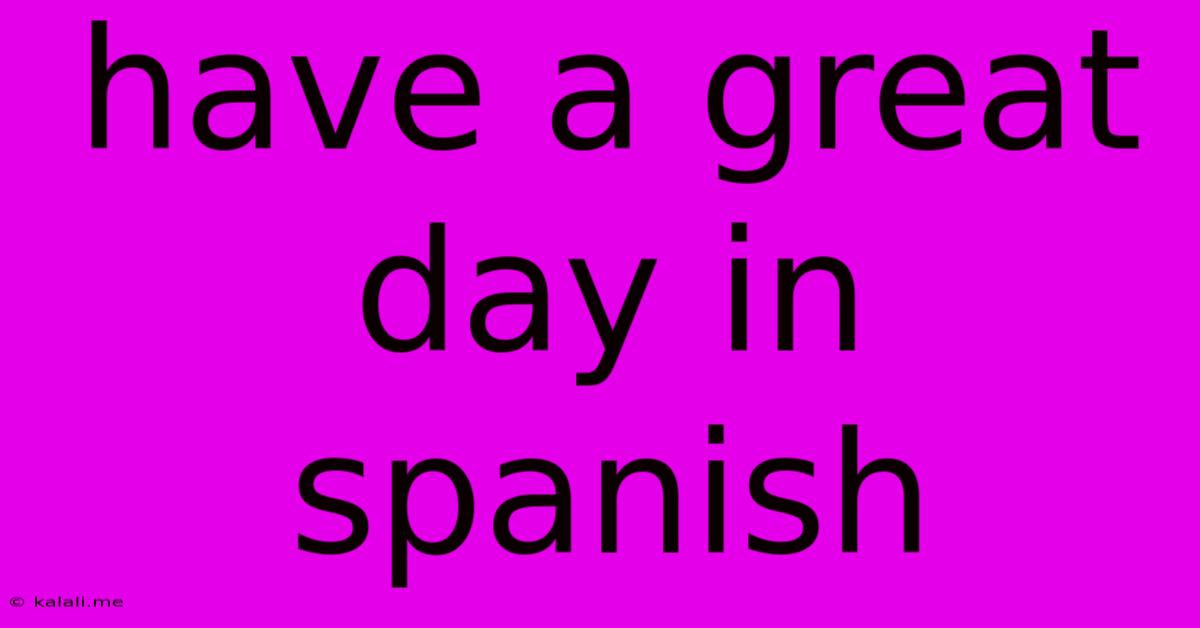Have A Great Day In Spanish
Kalali
May 22, 2025 · 3 min read

Table of Contents
Have a Great Day in Spanish: More Than Just "Que Tenga Un Buen Día"
Want to wish someone a wonderful day in Spanish? While "Que tenga un buen día" is a perfectly acceptable and common phrase, there's a whole spectrum of ways to express this sentiment, depending on the context and your relationship with the person. This article explores various options, from formal to informal, and offers insights into their nuanced meanings. This will help you choose the perfect phrase for every situation, ensuring your Spanish greetings are both accurate and authentic.
Knowing how to say "have a great day" in Spanish is a valuable skill for anyone learning the language. It's a simple yet impactful way to connect with Spanish speakers, showing politeness and consideration. This guide will equip you with the knowledge and vocabulary to do just that.
Common Ways to Say "Have a Great Day" in Spanish
The most straightforward translation is "Que tenga un buen día". This is a perfectly polite and universally understood phrase, suitable for most situations, from casual encounters to more formal settings. It literally translates to "that you have a good day."
However, Spanish offers many alternatives, each adding a different flavor to your greeting:
-
"Que tengas un buen día": This is the informal version, used when speaking to friends, family, or people you know well. The verb changes from "tenga" (formal "you") to "tengas" (informal "you").
-
"¡Que tengas un excelente día!": This adds a touch of extra enthusiasm. "Excelente" means "excellent," conveying a wish for a truly exceptional day. This is suitable for close friends or family.
-
"¡Que pase un buen día!": This translates to "Have a good day!" and uses the verb "pasar" (to spend or pass), implying a pleasant spending of the day. This option is also suitable for both formal and informal situations.
-
"¡Buen día!": This is a shorter, more concise greeting, similar to "Good day!" in English. It's perfectly acceptable and commonly used, especially in more formal contexts.
-
"¡Qué le vaya bien!": This translates to "May things go well for you!" or "Have a good one!" This option is slightly more indirect but conveys a similar sentiment of well-wishing.
Choosing the Right Phrase: Context Matters
The best phrase depends on the context:
-
Formal settings: Stick to "Que tenga un buen día" or "Buen día."
-
Informal settings: Feel free to use "Que tengas un buen día," "¡Que tengas un excelente día!", or "¡Qué le vaya bien!"
-
Close friends and family: "¡Que tengas un excelente día!" or even a more casual "Que tengas un buen día" works perfectly.
Beyond the Basics: Adding Personal Touches
You can enhance your greeting by adding a personal touch:
-
"Que tengas un buen día, [Name]": Adding the person's name personalizes the greeting.
-
Combine with other expressions: You could say "Que tengas un buen día, ¡hasta luego!" ("Have a good day, see you later!") or "Que tengas un buen día, ¡cuidate!" ("Have a good day, take care!")
Mastering these variations allows for a more natural and expressive way to wish someone a great day in Spanish. Remember to practice and choose the phrase that best suits the situation and your relationship with the person you're addressing. With a little practice, you'll be fluent in expressing your well wishes in Spanish in no time!
Latest Posts
Latest Posts
-
Can A Latex Command Start With Number
May 23, 2025
-
Your Kindness Is Matched Only By Your
May 23, 2025
-
Dmesg Read Kernel Buffer Failed Operation Not Permitted
May 23, 2025
-
Bathroom Vent Fan Attic Power Outlet
May 23, 2025
-
How Do You Run A Wire In Fallout 4
May 23, 2025
Related Post
Thank you for visiting our website which covers about Have A Great Day In Spanish . We hope the information provided has been useful to you. Feel free to contact us if you have any questions or need further assistance. See you next time and don't miss to bookmark.